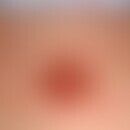Synonym(s)
HistoryThis section has been translated automatically.
DefinitionThis section has been translated automatically.
Humapathogenic virus species belonging to the family Polyomaviridae and the genus Polyomavirus. These are approximately 50 nm large, non-enveloped viruses with a double-stranded, circularly convalently closed DNA genome (DNA viruses) of approximately 5000 base pairs. The nucleocapsid is formed from the three structural porins VP1,-2 and-3, with VP1 being the major capsid.
In the normal population, antibodies against BK virus can be detected to 100% and against JC virus to about 80%. Infection occurs in early childhood and is usually asymptomatic. Under conditions of immunosuppression (see below organ transplants, skin changes), polyomaviruses persisting in the organism can be reactivated (reactivation with virus multiplication in the blood).
The disease that then breaks out typically becomes symptomatic in two forms, especially for transplanted patients, as:
- BK virus nephropathy (polyoma virus associated kidney disease) and as
- hemorrhagic cystitis.
JC virus (JCV) causes progressive multifocal leukoencephalopathy (PML) in cellular immunocompromised individuals (e.g., HIV-infected individuals, e.g., psoriatic patients treated long-term with efalizumab ). PML is almost always fatal.
You might also be interested in
General informationsThis section has been translated automatically.
In recent years, several different species of human polyomaviruses have been identified:
- BK viruses (isolated in the urine of a kidney transplant patient with the initials B.K.).
- JC viruses(isolated in Hodgin's lymphoma of a pat. with the initials J.C.).
- BK and JC viruses are also known as polyomavirus hominis types 1 and 2. Both viruses have been found in normal and lesional tissues of patients with Kaposi's sarcoma.
- JVC is the causal agent in pat. with progressive multifocal leukoencephalopathy.
- KIPyV and HUPyV have been isolated from children with respiratory diseases.
- Simian virus 40 (SV40), a natural infectious agent in rhesus (simian = monkey) monkeys is a potential causative agent of several tumor diseases. Thus, SV40 has been detected in 47% to 83% of human mesothelioma cases. The pathogenetic role is currently unclear (Carbone M 1999) .
- Other members of the polyomavirus genus include human polyomavirus KI (KIPyV9), human polyomavirus WU (WUPyV) , a new human polyomavirus highly associated with Merkel cell carcinoma (Merkel cell polymavirus MCPyV).
- TSPyV may be associated with a rare condition in immunosuppressed individuals, trichodysplasia spinulosa.
DiagnosisThis section has been translated automatically.
Note(s)This section has been translated automatically.
LiteratureThis section has been translated automatically.
Ahsan N et al (2006) Polyomaviruses and human diseases. Adv Exp Med Biol577:1-18.
Carbone M (1999) Simian virus 40 and human tumors: It is time to study mechanisms. J Cell Biochem 76:189-193.
-
De Gascun CF et al (2013) Human polyomavirus reactivation: disease pathogenesis and treatment approaches. Clin Dev Immunol 2013:373579.
Imperiale MJ et al (2016) Polyomavirus Persistence. Annu Rev Virol 3:517-532. -
Lamarche C et al. (2016) BK polyomavirus and the transplanted kidney: immunopathology and therapeutic approaches. Transplantation 100:2276-2287.
Moens U et al. (2008) Human polyomavirus and cancer: further insights. JDDG 6: 704-708 Hof H (2019) Special virology. In: Hof H, Schlüter D, Dörries R, eds Duale Reihe Medizinische Mikrobiologie. 7th, completely revised and expanded edition. Stuttgart: Thieme p 263-265
Incoming links (7)
Classification of viruses; Efalizumab; Mcpyv large t-antigen; Merkel cell carcinoma; Organ transplants, skin changes; Polyomaviridae; Trichodysplasia spinulosa ;Outgoing links (4)
Efalizumab; Merkel cell carcinoma; Organ transplants, skin changes; Trichodysplasia spinulosa ;Disclaimer
Please ask your physician for a reliable diagnosis. This website is only meant as a reference.





